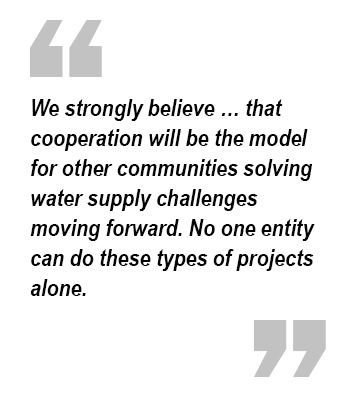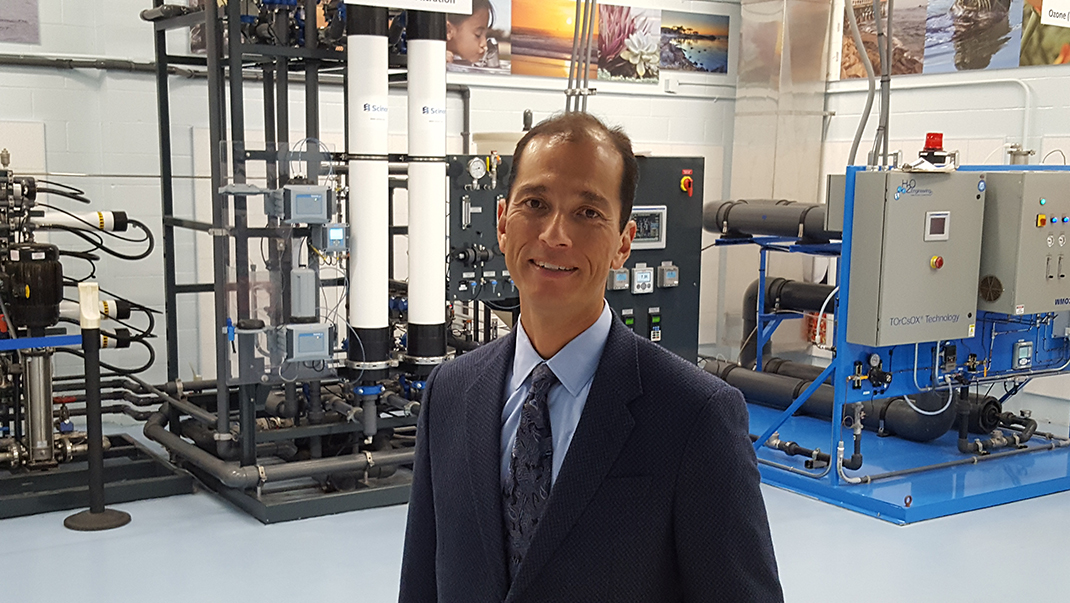The concept of One Water has firm roots in California, and the Monterey Regional Water Pollution Control Agency, which changed its name this year to Monterey One Water, is about to become a big part of it. General Manager Paul Sciuto is helping to diversify the Monterey Peninsula’s water supply portfolio with an ambitious project called Pure Water Monterey. BC Vice President Grace Chow talked with Sciuto about the project and the agency’s commitment to resolving the area’s water supply challenges.
Tell us about the challenges your agency faces in developing sustainable water supplies. After all, you help supply water to what’s known as the “Salad Bowl” of the nation – lettuce, broccoli, artichokes, strawberries, and an array of other high value crops that feed the nation. How does the Monterey Peninsula manage a water supply with so many demands?
Making sure there’s an adequate water supply to fuel this region’s economic engine is quite a responsibility, and one we have to approach innovatively and collaboratively to be successful. For example, Monterey County agriculture is a $4 billion industry, provides two-thirds of the nation’s leafy greens. As agriculture is the backbone of the region’s economy, water is our lifeblood. To our knowledge, MRWPCA operates the world’s largest water recycling facility designed to irrigate freshly edible food crops.
But the recent drought and continued conservation efforts by residents has had a dramatic effect on our wastewater flows into the treatment plant. This reduction of inflows has created an opportunity for us to evaluate accepting other water sources into the plant.
We’ve just broken ground on the $100 million Pure Water Monterey groundwater replenishment project, which is an integrated water recycling approach that we hope will diversify Monterey’s water supply and improve the overall water quality in the Salinas Valley Groundwater Basin. The project will tap various underutilized wastewater sources for treatment in order to provide a supply that exceeds drinking water standards. The purified water will be used by Peninsula homes and businesses after residing in the underground aquifer for over 6 months. The additional wastewater not utilized by Pure Water will enhance the recycled water supply for Salinas Valley agricultural irrigation.
The project will be the first of its kind to use not just wastewater, but stormwater, food industry processing water and impaired surface waters. We hope it serves as a model for other California communities. The concept of using these waters for beneficial reuse has garnered the attention of many local, state and national officials and is moving our region into the forefront for recognizing that all water has value.
The use of various source waters is different than some of the other groundwater replenishment projects? Why is that?
We were fortunate to have a couple of water sources that were near existing infrastructure. The Reclamation Ditch, which conveys agricultural drainage water, crosses over a main sewer interceptor for the City of Salinas and the industrial wastewater and stormwater pipelines are within 100 feet of the agency’s Salinas Pump Station. We wanted to bring these water sources into the treatment plant to be reused because of the underutilized capacity in the conveyance and treatment facilities due to conservation. Technically speaking, all future waters will receive the same primary and secondary treatment.
Once the Advanced Water Purification Facility is built, a portion of the flows will be sent one direction for advanced treatment and the other flows will go to our tertiary treatment facility and be used for agriculture irrigation.
One other interesting aspect to the project is that we are going to be using ozone as a pre-treatment prior to full advanced treatment. Based on our water quality testing, the ozone treatment process will help the downstream membranes work more efficiently.
Pure Water Monterey has been lauded by some as a model for regional collaboration, and even the “wave of the future” for the rest of California. What makes this project so special?
 I think there are two aspects of the project that are really unique. The first is that Pure Water Monterey will generate a replacement water supply for the region and provide additional irrigation supplies for agriculture.
I think there are two aspects of the project that are really unique. The first is that Pure Water Monterey will generate a replacement water supply for the region and provide additional irrigation supplies for agriculture.
The proposal is designed to provide 3,500 acre-feet of potable water for injection into the Seaside Groundwater Basin, where it will mix with native groundwater and eventually be pumped out for later use. California American Water wants to purchase water for its Monterey district customers by 2019, and this project will allow that. It would also save water from having to be pumped from the Salinas Valley Basin because highly contaminated runoff could be transformed into as much as 5,600 acre-feet of secondary treated water for farmland irrigation. This also helps in the effort to offset seawater intrusion.
 The second and probably the most important aspect of the project is the collaborative efforts among the various entities in and around the Monterey Peninsula and the Salinas Valley. It has been unbelievable. The project is backed by a public-private partnership between the MRWPCA, the Monterey Peninsula Water Management District and California American Water. There were several other local public agencies who contributed to the process. These entities include: City of Salinas, Marina Coast Water District, Monterey Regional Waste Management District, Fort Ord Reuse Authority, City of Seaside, Monterey County Water Resource Agency, United States Bureau of Reclamation, Monterey County Board of Supervisors.
The second and probably the most important aspect of the project is the collaborative efforts among the various entities in and around the Monterey Peninsula and the Salinas Valley. It has been unbelievable. The project is backed by a public-private partnership between the MRWPCA, the Monterey Peninsula Water Management District and California American Water. There were several other local public agencies who contributed to the process. These entities include: City of Salinas, Marina Coast Water District, Monterey Regional Waste Management District, Fort Ord Reuse Authority, City of Seaside, Monterey County Water Resource Agency, United States Bureau of Reclamation, Monterey County Board of Supervisors.
We strongly believe this level of cooperation will be the model for other communities solving water supply challenges moving forward. No one entity can do these types of projects alone.
Can you tell us specifically about the challenges and successes of collaboration in reaching a One Water implementation model and what advice you would give others?
Early on when the project was just being considered by the various entities, the dialogue between the parties was stagnant. Information was being exchanged at each meeting but a fair amount of time was spent going over the minutiae. It wasn’t until all the right people were seated at the table did progress get made on hammering out a deal. One of the key successes of the project was getting the other parties to help sell the project to their constituents.
The second piece of advice I would suggest is make sure you have the right players on the team. These projects are very complicated and you need the right advice from those individuals or businesses that have been there before and are trusted. A true partner will tell you things that you didn’t really care to hear but for the overall good of the project will help you come up with solutions for these challenges. We have been really fortunate to have staff and consultants alike that believed in this transformational project and have moved proverbial mountains to make it a reality.
Always have a Plan B. Whether Plan B is another engineering option, or calling in a favor to get a meeting with a particular person, it never hurts to be prepared for the somewhat unlikely to occur event.
Tell us about the name change from Monterey Regional Water Pollution Control Agency to Monterey One Water.
Based on projects like Pure Water Monterey and future stormwater diversion projects, the ability to reuse water is very consistent with the goals of the State of California as well as diversifying the local water supply portfolio. This One Water concept is gaining momentum across the country as regions try to develop and utilize new water resources. The board has embraced the concept of utilizing these additional water sources as critically important to the region’s future supply.
We (board and staff) recently looked at the agency’s core mission and brand. During these meetings, it was revealed that the current agency name did not reflect the vision and direction of the agency’s future purpose. At a recent board meeting, the directors wanted to recognize this paradigm shift in a more visible and meaningful manner and approved Monterey One Water as the agency’s new name.
One of our partners in this process, Salinas Public Works Director Gary Petersen, is also a big advocate of the One Water concept. This type of revelation by influential thought leaders helps to shape the thinking of new water projects as well as trying to repurpose existing infrastructure for maximum benefit.
What do you like to do when you aren’t solving large water supply problems for the Central Coast?
I enjoy spending time with my kids. The Monterey Peninsula is such a scenic place that I enjoy getting outdoors as much as I can. I’ve competed in several Ironmans, so I try to run, bike and swim as much as my schedule will allow.
